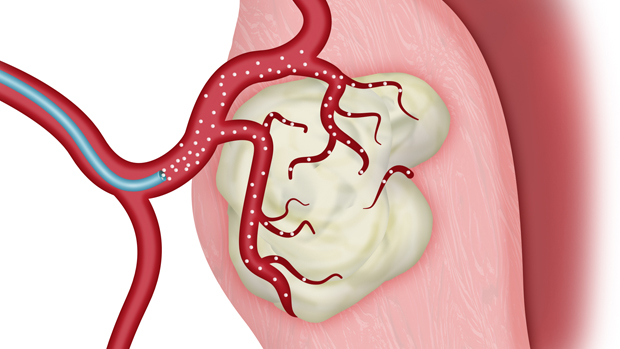Embolization is a minimally invasive medical procedure that blocks one or more arteries or veins, typically performed by an interventional radiologist. Over the past few decades, embolization has revolutionized the treatment of many conditions by providing an alternative to more invasive surgery.
How it Works?
Vascular Embolization works by carefully inserting a thin tube called a catheter into an opening in the groin or arm. Using specialized imaging like fluoroscopy, the interventional radiologist navigates the catheter through the blood vessels to the target site. Small particles, coils, or liquid agents are then injected through the catheter to block the blood flow in that vessel.
The goal is to block the blood supply to an abnormality without significantly compromising normal tissue. By depriving a pathological area of its blood supply, embolization can help treat various conditions. The blocked vessel eventually gets scarred and closed off, rerouting blood to healthy collateral vessels. This minimally invasive approach allows targeted treatment without major surgery.
Conditions It Treats
Embolization is used to treat a wide variety of benign and malignant conditions throughout the body. Some common applications include:
– Uterine Fibroids
Fibroids are non-cancerous growths that develop in the uterus. Embolization blocks the uterine arteries supplying blood to the fibroids, causing them to shrink significantly in size. This can help relieve heavy bleeding and painful periods.
– Brain Aneurysms
An aneurysm is a weak bulge or ballooning in an artery wall. Embolization seals off the base of brain aneurysms before they burst, preventing life-threatening hemorrhages. This avoids the risks of open brain surgery.
– Liver Tumors
Whether cancerous like hepatocellular carcinoma or benign like hemangiomas, liver tumors can be embolized to cut off their blood supply. This makes them shrink and die off, providing an alternative to partial liver resection.
– Kidney Cancer
Certain types of small kidney cancers, especially those in high-risk patients, can be treated with embolization instead of open surgery like nephrectomy. Cutting off the renal artery effectively occludes the tumor.
Benefits over Surgery
The key advantage of Vascular Embolization is that it is much less invasive than surgery, without the need to make large incisions or cut through tissues. Some notable benefits over open surgery include:
– Faster recovery – Patients can often go home the same day and return to normal activities within a week. Surgery requires longer hospital stays and recovery periods.
– Lower risks – Since there is no general anesthesia or incisions involved, risks of bleeding, infection and anesthetic complications are greatly reduced with embolization.
– Preserves organ function – For many conditions like fibroids and liver tumors, embolization spares most of the organ, maintaining its function compared to partial resection with surgery.
– Repeatable treatment – If needed, embolization can often be repeated on the same patient as the condition recurs or progresses. Additional surgeries carry higher risks each time.
– Cost effectiveness – As an outpatient procedure without lengthy hospitalization, embolization saves significant costs compared to major surgery and subsequent complications.
Limitations and Precautions
While embolization offers many advantages, it is not suitable treatment for every condition. Some key limitations and precautions for embolization include:
– Only works for conditions supplied by known arterial blood flow – Not effective if pathological area’s blood supply cannot be isolated.
– Size and location of target – Very small or deep-seated lesions may be difficult to access via catheterization.
– Post-procedure care required – Patients need to follow advice on activities, medications and follow-up imaging to monitor treatment success.
– Complications possible – Though rare, there is a small risk of damage to adjacent structures, infection, bleeding or reactions to devices/agents used. Immediate treatment may be required in some cases.
*Note:
1. Source: Coherent Market Insights, Public sources, Desk research
2. We have leveraged AI tools to mine information and compile it

